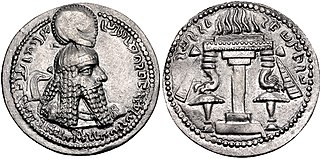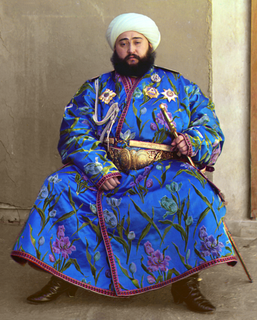 W
WTraditional Persian clothing can be seen in Persian miniature paintings, employ both vivid and muted colors for clothing, although the colors of paint pigment often do not match the colors of dyes.
 W
WA bashlyk, also spelled bashlik, is a traditional Turkic, Caucasian, Iranian, and Cossack cone-shaped headdress hood, usually of leather, felt or wool, an ancient round topped felt bonnet with lappets for wrapping around the neck. Local versions determine the trim, which may consist of decorative cords, embroidery. metallized strings, fur balls or tassels. Among dozens of versions are winter bashlyks worn atop regular headdress, cotton bashlyks, homeknitted bashlyks, silk bashlyks, scarf bashlyks, down bashlyks, dress bashlyks, jumpsuit-type bashlyks, etc. Bashlyks are used as traditional folk garment, and as uniform headdress.
 W
WA chādor, also variously spelled in English as chadah, chad(d)ar, chader, chud(d)ah, chadur, and naturalized as, is an outer garment or open cloak worn by many women in Iran, Iraq, and some other countries under the Persianate cultural sphere, as well as predominantly Shia areas in public spaces or outdoors. A chador is a full-body-length semicircle of fabric that is open down the front. The garment is pulled over the head and is held closed at the front by the wearer; the chador has no hand openings, buttons or clasps. It may also be held closed by being tucked under the wearer's arms.
 W
WLuri culture has been developed along with the long history of coexistence among Lurs with surrounding natural elements across the Iranian plateau, and geographical, cultural and religious effects.
 W
WThawb, also spelled thobe or tobe and known by various other names in different regions, is an ankle-length dress, usually with long sleeves. It is commonly worn in the Arabian Peninsula and the Middle East, Iran, neighbouring Arab countries, and some countries in East and West Africa. An izaar is typically worn underneath.
 W
WKolah Namadi is a traditional Iranian wool felt hat worn by men in parts of Iran. They come in variety of colours and shapes depending on the region in Iran or the clan that wears it. Today they are worn mostly for ceremonial purposes.
 W
WThe Korymbos was a jewel-studded globe containing the top hair of the ruler of the Sasanian dynasty of Iran, resting on his crown. It was introduced by Ardashir I. The art historian Matthew P. Canepa notes that although the Greek word Korymbos or Latin Corymbus has become a scholarly convention to refer to the spherical shape on the top of Sasanian crowns, it is not an indigenous Iranian term.
 W
WA kulāf, or kolāh, is a type of cap that designated Sasanian nobility and official. It appears on numerous reliefs and seals of the Sasanian Empire period.
 W
WThe Pahlavi hat was an item of headgear for men introduced in the Imperial State of Iran by Reza Shah.
 W
WThe Parthian dress, represented by the Parthians, became the common clothing in the Ancient Near East during the Arsacid era. The dress was characterized by its sleeved coats and trousers, and crossed political and ethnic barriers, being worn from Syria to northern India, continuing designs already recorded in the Achaemenid era. Alexander the Great's conquests of the Near East and the ensuing reign of the Seleucid Empire did not mark any change in Iranian clothing, but instead resulted in the further spread of it and even its influence on Greek clothing.
 W
WSasanian dress, represented by the Persians, was "broadly similar" to dresses worn by other Iranian peoples. It was especially appropriate and applicable for horse riding. Most extant primary sources for the study of Sasanian dress are forms of visual art, rock reliefs in particular. In relation to the Sasanian dress, Matthew Canepa (2018) states:It consisted of loose-fitting trousers, boots, and a knee-length tunic that was bound with a belt (kamar). A heavy caftan, crossed at the chest, could be worn belted. In 3rd- and 4th-century representations, the tunic appears squared off at the bottom. From the late 4th century, the lower hem is rounded. Ornamental and figural textile motifs become prominent around the 6th and 7th centuries, as is apparent at Taq-e Bostan. Early reliefs and seals portray members of the aristocracy wearing domed or pointed hats (kulāf) with their heraldic symbols (nīšān) on the side, often bound with diadems. Nobles were given the right to wear silk and jewellery. Women’s dress consisted of long, flowing, sleeved or sleeveless tunics. They were worn belted under the breasts with a long cloak worn over the left shoulder or used as a veil. Clothing was an important element in royal gift-giving. It also marked social rank, as did jewellery, and textiles and their motifs. The king bestowed clothing and jewellery as a mark of distinction on those he desired to honour and presented his own robes to especially favoured family and courtiers.
 W
WTermeh is a type of Persian (Iranian) handwoven cloth, produced primarily in the Isfahan province. Now the Yazd Termeh is the most beautiful and famous in the world. Yazd is the center of the design, producing and marketing of Termeh. Weaving termeh requires a good wool with long fibers. Termeh is woven by an expert with the assistance of a worker called a Goushvareh-kesh. Weaving termeh is a sensitive, careful, and time-consuming process; a good weaver can produce only 25 to 30 centimetres in a day. The background colors used in termeh are jujube red, light red, green, orange and black. Termeh has been admired throughout history; Greek historians commented on the beauty of Persian weavings in the Achaemenian, Ashkani and Sasanidae periods and the Chinese tourist Hoang Tesang admired termeh.
 W
WTiraz are medieval Islamic embroideries, usually in the form of armbands sewn onto robes of honour (khilat). They were bestowed upon high-ranking officials who showed loyalty to the Caliphate, and given as gifts to distinguished individuals. They were usually inscribed with the ruler's names, and were embroidered with threads of precious metal and decorated with complex patterns. Tiraz were a symbol of power; their production and export were strictly regulated, and were overseen by a government-appointed official.
 W
WA turban is a type of headwear based on cloth winding. Featuring many variations, it is worn as customary headwear by people of various cultures. Communities with prominent turban-wearing traditions can be found in the Indian subcontinent, Southeast Asia, the Arabian Peninsula, the Middle East, the Balkans, the Caucasus, Central Asia, North Africa, West Africa, East Africa, and amongst some Turkic peoples in Russia as well as Ashkenazi Jews.
 W
WZardozi or Zar-douzi, also Zardosi , work is a type of embroidery in Iran, Azerbaijan, Iraq, Kuwait, Syria, Turkey, Central Asia, India, Pakistan and Bangladesh. Zardozi comes from two Persian words: zar or zarin meaning 'gold', and dozi meaning 'sewing'. Zardozi is a type of heavy and elaborate metal embroidery on a silk, satin, or velvet fabric base. Designs are often created using gold and silver threads and can incorporate pearls, beads, and precious stones. It is used as decoration for a wide range of applications, including clothes, household textiles, and animal trappings. Historically, it was used to adorn the walls of royal tents, scabbards, wall hangings and the paraphernalia of regal elephants and horses.